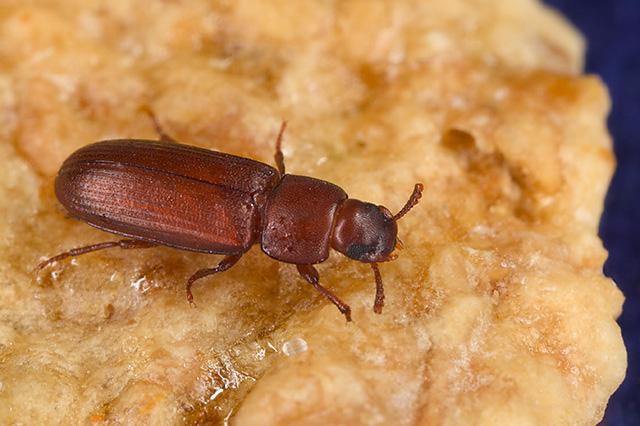storage pest on:
[Wikipedia]
[Google]
[Amazon]
A storage pest is an insect or other animal that damages or destroys stored food or other valuable organic matter. Insects make up a large proportion of storage pests, with each type of crop having specific insects that gravitate towards them. For example, insects of the genus '' Tribolium'', such as ''Tribolium castaneum'' (
 There are two types of grain insect pests, primary and secondary pests.
There are two types of grain insect pests, primary and secondary pests.



red flour beetle
The red flour beetle (''Tribolium castaneum'') is a species of beetle in the family Tenebrionidae, the darkling beetles. The red flour beetle, and other closely related beetles like '' Gnatocerus cornutus'', are a worldwide pest of stored produc ...
) or ''Tribolium confusum'' ( confused flour beetle), primarily damage flour crops.
Insects
Insects can partially damage or even completely destroy crops. By decreasing the protein content and removing the seeds from the grains, insects can affect the quality of the crop and its ability to germinate new ones.Types of insect pests
 There are two types of grain insect pests, primary and secondary pests.
There are two types of grain insect pests, primary and secondary pests.
Primary pests
Primary grain pests attack the whole grain. The eggs are laid inside the grain, before thelarva
A larva (; : larvae ) is a distinct juvenile form many animals undergo before metamorphosis into their next life stage. Animals with indirect development such as insects, some arachnids, amphibians, or cnidarians typically have a larval phase ...
e mature inside the grain and then chew their way out. Some of these pests include the Lesser grain borer, Granary weevil (''Sitophilus granarius'', the Wheat weevil) and Rice weevil (''Sitophilus oryzae'').
= Lesser grain borer (''Rhyzopertha dominica'')
= The lesser grain borer has a dark coloured cylindrical structure with the head concealed. When lesser grain borer eggs are laid, they are laid outside the grain, however they mature inside the shell of the seed which can take up to 6 weeks if the temperature is cooler, with the adult borers not living for longer than two months. This species is known to damage storedwheat
Wheat is a group of wild and crop domestication, domesticated Poaceae, grasses of the genus ''Triticum'' (). They are Agriculture, cultivated for their cereal grains, which are staple foods around the world. Well-known Taxonomy of wheat, whe ...
, maize
Maize (; ''Zea mays''), also known as corn in North American English, is a tall stout grass that produces cereal grain. It was domesticated by indigenous peoples in southern Mexico about 9,000 years ago from wild teosinte. Native American ...
/corn and other cereal
A cereal is a grass cultivated for its edible grain. Cereals are the world's largest crops, and are therefore staple foods. They include rice, wheat, rye, oats, barley, millet, and maize ( Corn). Edible grains from other plant families, ...
crops with the seeds becoming hollowed out husks. Products with small infestations should be discarded however the grains can be treated with smaller amounts of spray. However, large infestations require more control, including complete fumigation.

= Rice weevil (''Sitophilus oryzae'')
= The adultrice weevil
The rice weevil (''Sitophilus oryzae'') is a stored product Pest (organism), pest which attacks seeds of several crops, including wheat, rice, and maize.
Description
The adults are usually between long, with a long snout. The body color appears ...
has an orange-black exoskeleton and lays up to 450 eggs in pores of the damaged grains with each hatched egg further damaging the grain from the inside. Similarly to the lesser grain borer, maturation also happens inside the grain with the matured adult rice weevil eating through the husk of the grain to get out. The life cycle is similar to that of the lesser grain borer in summer months (approximately one month) and adult weevils live up to 8 months after the experience their life cycle.

Secondary pests
Secondary grain insects feed on broken grain and any powder products left as a result of the broken grain. These pests include the genus ''Tribolium'', beetle species and moth species.= Rust-red flour beetle (''Tribolium castaneum'')
= TheRed flour beetle
The red flour beetle (''Tribolium castaneum'') is a species of beetle in the family Tenebrionidae, the darkling beetles. The red flour beetle, and other closely related beetles like '' Gnatocerus cornutus'', are a worldwide pest of stored produc ...
or Rust-red flour beetle is a red-brown beetle with an exoskeleton that darkens in colour as the beetle increases in age, with the maximum adult age being a year. Unlike primary pests, Rust-red flour beetles can produce up to 1000 eggs and lay them inside the damaged grain with parts of the larvae able to use the damaged grains and cereal as their food source.

= Warehouse moth (''Ephestia elutella'') {{anchor, Warehouse moth
= The Warehouse moth is a grey moth that remains on the surface of the grain with the female moth laying up to 200 eggs, however their life span is only 2 weeks long with a 4 week life cycle. Similarly to other secondary pests, the Warehouse moth eggs use the surface of the grain, although when the larvae hatch they leave a stream of silk that encapsulates the surface of the grain which can then be used as a cocoon for mature larvae.References